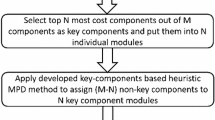Abstract
The development of modular products is diffused in modern production due to the achievable flexibility and to the required product personalization. Modular products can maximize the efficiency of productive processes if they are structured to be easily configurable during the assembly phase. In this context the present work proposes an approach to optimize the product’s modular architecture aimed to improve manual assemblability. The goal of this method is to assess the product assembly sequence during the early design stage. In particular it improves the conceptual design for assembly approach by taking into account the role of different flows in the modular product structure and the types of interface between modules. A case study regarding the household appliance field is reported and it allows the method results to be shown and to highlight advantages and drawbacks. A relevant improvement in terms of the reduction of assembly time is obtained.
Similar content being viewed by others
References
Zha X.F., Du H.J., Qiu J.H.: Knowledge-based approach and system for assembly oriented design, Part I: the approach. Eng. Appl. Artif. Intell. 14, 61–75 (2001)
Selvaraj P., Radhakrishnan P., Adithan M.: An integrated approach to design for manufacturing and assembly based on reduction of product development time and cost. Int. J. Adv. Manuf. Technol. 42, 13–29 (2009)
Boothroyd G., Dewhurst P., Knight W.: Product Design for Manufacture and Assembly. Marcel Dekker, New York (2002)
De Fazio T.L., Rhee S.J., Whitney D.E.: Design-specific approach to design for assembly (DFA) for complex mechanical assemblies. IEEE Robotics Autom. 15(5), 869–881 (1999)
Stone R.B., McAdams D.A.: A product architecture-based conceptual DFA technique. Des. Stud. 25, 301–325 (2004)
Stone R.B., Wood K.L., Crawford R.H.: A heuristic method for identifying modules for product architectures. Des. Stud. 21(1), 5–31 (2000)
Stone R.B., Wood K.L., Crawford R.H.: Using quantitative functional models to develop product architectures. Des. Stud. 21(3), 239–260 (2000)
Pahl G., Beitz W.: Engineering Design: A Systematic Approach. 2nd edn. Springer, (1996)
Ulrich K., Eppinger S.: Product Design and Development. McGraw-Hill, New York (1995)
Teng, X., Kong, F., Zhang, J.: Methods supporting product modular design for assembly. In: Proceedings of the International Conference on Measuring Technology and Mechatronics Automation (ICMTMA), vol. 3, pp. 789–793 (2009)
Otto K., Wood K.: Product design: techniques in reverse engineering and new product development. Prentice Hall, New Jersy (2001)
Edwards K.L.: Towards more strategic product design for manufacture and assembly: priorities for concurrent engineering. Mater. Des. 23, 651–656 (2002)
Suzuki, T. et al.: Assembly reliability evaluation method (AREM). In: Proceedings of the IEEE International Symposium on Assembly and Task Planning (2001)
Lucas Engineering Systems Ltd, University Of Hull, Design For Manufacture and Assembly Practitioners Manual. Version 10 (1993)
Samy S.N., ElMaraghy H.A.: A model for measuring products assembly complexity. Int. J. Comput. Integr. Manuf. 23(11), 1015–1027 (2010)
Samy, S.N., ElMaraghy, K.H.: Assessment of complexity measures suitable for mechanical assemblies. In: Proceedings on 2nd CIRP Conference on Assembly Technologies and Systems, Toronto, ON, Canada (2008)
Maropoulos P.G., Vichare P., Martin O., Muelaner J., Summers M.D., Kayani A.: Early design verification of complex assembly variability using a hybrid—model based and physical testing—methodology. CIRP Ann. Manuf. Technol. 60, 207–210 (2011)
Dahmus J.B., Gonzalez-Zugasti J.P., Otto K.N.: Modular product architecture. Des. Stud. 22(5), 409–424 (2001)
Mikkola J.H.: Capturing the degree of modularity embedded in product architectures. J. Prod. Innov. Manag. 23, 128–146 (2006)
Xiaoyan, T. Fankai, K., Jiatai, Z.: Methods supporting product modular design for assembly. In: Proceedings of the International Conference on Measuring Technology and Mechatronics Automation (2009)
Azman Y., Nurnasran P., Ruslizam D., Mazni O., Sharifah Lailee S.-A.: Product assembly sequence optimization based on genetic algorithm. Int. J. Comput. Sci. Eng. 02(09), 3065–3070 (2010)
Ulrich, K.: The role of product architecture in the manufacturing firm. Res. Policy 24 (1995)
Dini G., Failli F., Lazzerini B., Marcelloni F.: Generation of optimized assembly sequences using genetic algorithms. Manuf. Technol. 48(1), 17–20 (1999)
Ma, X., Kim, M.: A systematic design for assembly method through the combination of subassemblies in product family. In: Proceedings on International Conference on Smart Manufacturing Application, Gyeonggi-do, Korea (2008)
Barnes, C.J., Dalgleish, G.F., Jared, G.E.M., Swift, K.G., Tate, S.J.: Assembly sequence structures in design for assembly. In: Proceedings of the IEEE International Symposium on Assembly and Task Planning (1997)
Nevis J.L., Whitney D.E.: Concurrent Design of Products and Processes: A Strategy for the Next Generation in Manufacturing. McGraw-Hill, New York (1989)
Owen A.E.: Flexible Assembly Systems: Assembly by Robots and Computer Integrated Systems. Plenum Press, New York (1984)
Su Q.: Computer aided geometric feasible assembly sequence planning and optimizing. Int. J. Adv. Manuf. Technol. 33, 48–57 (2007)
Chen, X., Gao, S., Yang, Y., Zhang, S.: Multi-level assembly model for top-down design of mechanical products. Computer-Aided Design (2011)
Demoly F., Yan X.T., Eynard B., Rivest L., Gomes S.: An assembly oriented design framework for product structure engineering and assembly sequence planning. Robotics Comput. Integr. Manuf. 27, 33–46 (2011)
Chen Y., Feng P., He B., Lin Z., Xie Y.: Automated conceptual design of mechanisms using improved morphological matrix. J. Mech. Des. 128(3), 516–527 (2006)
Author information
Authors and Affiliations
Corresponding author
Rights and permissions
About this article
Cite this article
Favi, C., Germani, M. A method to optimize assemblability of industrial product in early design phase: from product architecture to assembly sequence. Int J Interact Des Manuf 6, 155–169 (2012). https://doi.org/10.1007/s12008-012-0147-y
Received:
Accepted:
Published:
Issue Date:
DOI: https://doi.org/10.1007/s12008-012-0147-y




